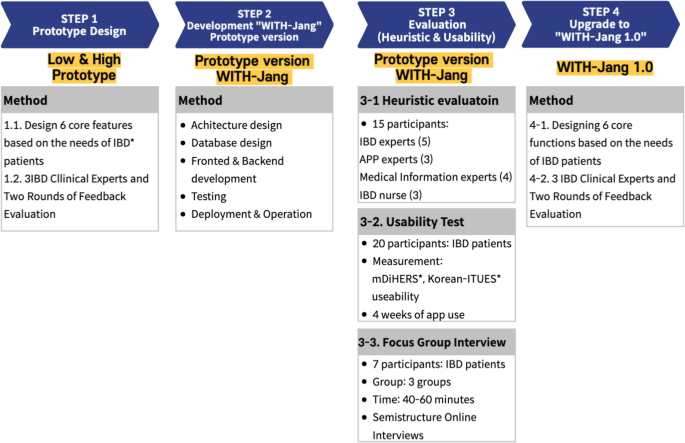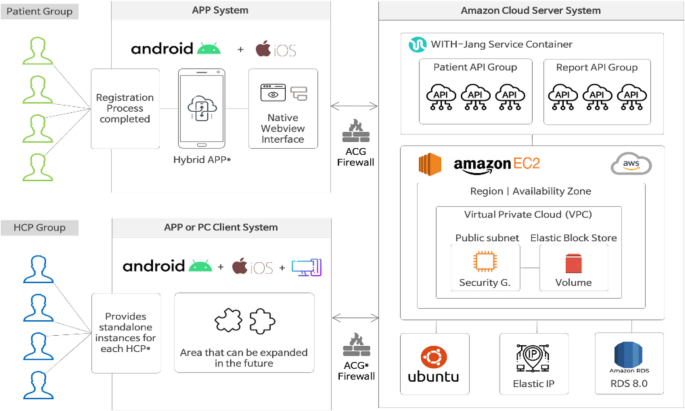User-needs based app for patients with inflammatory bowel disease: development and usability study | BMC Health Services Research

Study design
The progress of this study is presented in (Fig. 1). Co-design, also referred to as user-centered design, involves a collaborative approach between developers and users throughout the design process and aims at refining the process by eliciting user requirements. This methodology is particularly critical during the development phases of health-related applications [17]. In this study, the key functionalities derived from the requirements of users (IBD patients) through a user-centered design approach were integrated from the outset of the mobile app development process.

Research process IBD: Inflammatory Bowel Disease; mDiHERS: Mobile-Centered Digital Health Readiness Scale: Health Literacy and Equity Scale; Korean Health-ITUES: Korean Version of the Health Information Technology Usability Evaluation Scale;
STEP 1. Prototype Design
In the preliminary study, five key features of a digital healthcare app were identified based on user requirements through a Co-Creation Workshop (CCW) involving eight IBD patients, one UX designer, one nursing and health informatics expert, and two nursing research specialists. The key features identified were A. Personalized symptom management, B. Simple and easy recording, C. Reliable Information, D. Alarm (Reminder), E. Communication between IBD patients [18]. Additionally, a sixth feature was incorporated based on user feedback—the desire for effective utilization of personal health data (“Use of my information”). These six features were applied during the design phase of the digital healthcare app for IBD patients, shaping both the menu and the functionality.
The selection of the app’s core components was not arbitrary, but grounded in both user input and prior evidence. During the co-creation workshop, IBD patients and healthcare professionals collaboratively identified significant challenges in daily disease management, such as difficulties in remembering medications, understanding symptom triggers, and communicating health status during clinical visits. As a result, key features such as symptom tracking, medication reminders, and health summary reports were prioritized. These features are also commonly emphasized in prior literature on IBD self-management apps [12, 13, 24], supporting their inclusion not only from a user experience standpoint but also from a research-informed perspective.
The UI of the digital healthcare mobile app for IBD patients was developed to enhance the user experience and facilitate effective two-way communication with healthcare providers. Both low-fidelity and high-fidelity prototypes were created, and feedback from IBD clinical experts was obtained twice throughout the process, leading to the development of the final functionality and UI. In this study, low-fidelity prototypes refer to rough and straightforward wireframes or sketches that illustrate the basic structure and layout of the app without detailed design elements. In contrast, high-fidelity prototypes represent visually refined and interactive mock-ups that closely resemble the final user interface and include realistic content, functions, and navigation flow.
-
1–1. First, based on the six key features derived from user requirements, a low-fidelity UI was developed by an informatics researcher and three nursing science specialists. The first round of feedback was obtained from three IBD clinical experts. Feedback was gathered through two rounds of evaluation, using semi-structured interviews conducted via Zoom online meetings. In the first round of feedback, a quantitative suitability assessment was performed, where each of the six core features was rated on a scale from 1 (very inappropriate) to 5 (very appropriate). Additionally, a qualitative assessment was conducted using three main questions regarding the strengths, weaknesses, and potential revisions for each feature.
-
1–2. After revising the prototypes based on the first round of feedback, high-fidelity prototypes were developed. The final version of the UI and functionality reflected the results from both rounds of feedback. For the second round of evaluation, the low-fidelity UI was revised and implemented as an APK (application package) file, which was sent to the evaluators via email in advance. The second round followed the same format as the first, with a 1:1 Zoom interview lasting approximately one hour. The interview focused on the app’s design, tone and manner, efficiency, user preferences, and potential further modifications.
STEP 2. Development of the WITH-Jang Prototype version
The architecture and infrastructure of the digital healthcare app for IBD patients were designed and developed to provide a foundation for digital health management and research, while ensuring adaptability for change in management and scalability. The database was structured to accommodate health management data and detailed health information reporting, considering the overarching themes of interrelated services for both IBD users and clinical experts. To ensure data security and usability, the app utilizes an EC2-based containerized API service controller from the Amazon Cloud Server System, providing flexibility in standardized code management and resource allocation.
During the app development process, the mobile app’s structure and data model were defined with consideration of client–server interactions, allowing for the safe storage and processing of collected data. Additionally, the app was designed to incorporate user feedback promptly and to continuously expand its functionality based on research outcomes and evaluations from healthcare professionals. This approach ensures the delivery of more efficient health management services to users while providing precise data to medical experts (Fig. 2).

Application System Framework. APP: Application; HCP: Health Care Provider; ACG: Application Control Gateway;
STEP 3. Evaluation
Heuristic Evaluation for Experts
To identify usability issues of the app in advance, 15 experts were recruited (5 IBD clinical experts, three app specialists, four medical informatics experts, and 3 IBD nurses). The clinical experts were physicians with research or treatment experience related to IBD patients, and the app specialists were developers with expertise in designing and developing health-related apps. Convenience sampling and snowball sampling methods were used for recruitment.
Heuristic evaluation is a method that leverages the expertise of specialists to detect visible usability issues in UI design [19], propose solutions, and prioritize these issues. This evaluation was conducted to enhance the core functionality and stability of the IBD digital healthcare app. The evaluation process involved downloading WITH-Jang 1.0 from the Android and App Store, using the app with a focus on its core functions, and then assessing the app.
The evaluation tool was based on Joyce’s (2016) expert heuristic evaluation (12 items) [20] and was conducted via an online survey using Google Forms. Joyce’s tool is one of the most recently published empirical evaluation tools for medical apps, distinguishing itself from other heuristic evaluations by marking each item with the term SMART (smartphone heuristics). The severity of each problem was assessed using a scale developed by Sauro, ranging from 0 to 3, where 0 indicates no discomfort, 1 indicates minor hesitation or annoyance, 2 indicates moderate interference that may cause failure in specific tasks, and 3 indicates severe disruption that leads to task failure. Lower scores indicate less severe usability issues, while higher scores signify more functional problems that impede app use. Additionally, each item allowed for open-ended responses where participants could provide feedback on issues, improvements, and suggestions.
Usability evaluation of app users
The study participants were IBD patients, and before participating in the study, the researcher explained the purpose and procedures of the study in person and obtained voluntary written consent. Participants who agreed to take part in the study completed a pre-survey to assess their digital readiness and used the digital healthcare app, WITH-Jang prototype version, for four weeks. Usability evaluation was conducted after the app usage, using the Korean Health Information Technology Usability Evaluation and small group interviews. A link to the Google survey was sent via the WITH LAB Kakao-Talk channel to encourage voluntary participation from users. Only participants who completed the survey received a nominal participation fee.
All surveys were consistently structured, and participants were asked for their consent to participate in small group interviews after the survey. The interviews were conducted online, consisting of questions related to the usability survey and their experience using the app.
Participants
The study participants were (1) adults aged 19 years or older, (2) individuals diagnosed with ulcerative colitis or Crohn’s disease, and (3) individuals capable of using mobile devices. Those who were unable to understand the study information or use mobile devices were excluded.
Assessment tools
Digital readiness (mDiHERS)
To assess the readiness of individuals to actively engage in digital health services for self-management of their health, the Development and Validation of a Mobile-centered Digital Health Readiness: Health Literacy and Equity Scale (mDiHERS) was used as a comprehensive tool [21]. This scale includes components of health literacy and equity to ensure the effective use of digital health services, including mobile apps. The questionnaire is composed of the following sections: Mobile Services Capability (10 items), mHealth Literacy: Understand and Utilize Mobile Health Apps and Devices (6 items), Perception of the Importance of mHealth Apps and Devices (3 items), Digital Health Equity (5 items), Characteristics Related to Digital Readiness (5 items), and User’s Characteristics (7 items).
The total score for digital readiness is calculated as the average score across the four domains, excluding characteristics related to digital readiness and user characteristics. Scores range from 1 to 5, with higher scores indicating greater readiness for using digital health services. In the mDiHERS study, the Cronbach’s α coefficient was reported from 0.84 to 0.91, while in this study, the Cronbach’s α coefficient was 0.796.
Korean-health ITUES
The tool is designed to evaluate the usability of health-related apps and systems, with a particular focus on user experience. ITUES was initially developed to assess the usability of digital health tools, such as mHealth apps, and the Korean version allows for usability evaluation targeting Korean-speaking users. The Korean version of the Health Information Technology Usability Evaluation Scale (Korean Health-ITUES) was used to assess app usability [22]. It consists of 20 items, with higher scores indicating greater usability. Each item is rated on a 5-point Likert scale, ranging from”strongly disagree”(1 point) to”strongly agree”(5 points). The scale is divided into four subdomains: effectiveness (3 items), perceived usefulness (9 items), perceived ease of use (5 items), and user control (3 items). In the study by Lee and Schnall [17], the Korean Health-ITUES showed a Cronbach’s α coefficient of 0.951, while in this study, the Cronbach’s α was 0.950.
Focus group interview after app usage
To facilitate in-depth discussions on the topic, focus group interviews were conducted with selected participants. Although the small sample size in focus groups may limit the representativeness of the findings, this method allows for free exchange of opinions and in-depth discussion among expert participants on specific topics [23]. The size of the focus group can vary depending on the research objectives and subject matter, but typically consists of 5–10 members per group, and theoretical saturation can be reached with 2–3 groups [24]. Based on this, in this study, focus group interviews were conducted with three groups, each consisting of 2–3 users who voluntarily agreed to participate after using the mobile healthcare app for four weeks. The interview questions were designed for this study and have not been previously published elsewhere. The interview questions have been uploaded as a supplementary file.
STEP 4. Upgrade to WITH-Jang 1.0
Based on the expert heuristic evaluation, usability assessment from 20 app users (IBD patients), and FGI results, the app was updated to WITH-Jang 1.0. The heuristic evaluation focused on addressing issues identified through an in-depth analysis of the app’s interface and functionality by experts. Additionally, the app was tested in real-world user environments, leading to updates that improved the user interface, optimized functionality, and enhanced accessibility.
Ethical considerations
This study was approved by the Institutional Review Board (IRB) of Severance Hospital, Yonsei University Health System, Seoul, Republic of Korea (IRB No. 4–2023-1147), and all participants provided written informed consent before participation. Furthermore, the study was conducted in accordance with the ethical guidelines set forth by the Declaration of Helsinki. Before conducting the study, all participants were provided with an explanation of the study, and informed consent was obtained prior to participation. All research-related data were collected solely for this study, and all information gathered from the participants was securely stored in encrypted files, accessible only by the principal investigator and authorized research team members. This study was registered with the clinical trial number KCT0010068 on December 19, 2024. The processed research data files were stored in a cloud database managed by the principal investigator, with access restricted to approved research team members only. This research was supported by the National Research Foundation of Korea (No.NRF-2021R1C1C1004505).
This study adheres to the mHealth Evidence Reporting and Assessment (mERA) checklist, developed by the WHO mHealth Technical Evidence Review Group, to enhance transparency and reproducibility in reporting digital health interventions. A completed checklist is available in Supplementary Table S1.
Statistical analysis
In this study, descriptive statistics were used to evaluate the significance of changes in the measurements before and after app usage, with the mean and standard deviation as the primary metrics of interest. During the focus group interviews, the research team recorded key points, and the collected interview data were categorized by themes through discussions among the researchers.
link




